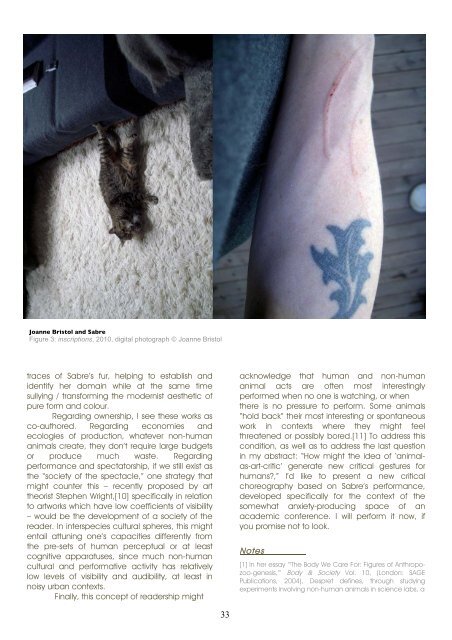Animal Influence I - Antennae The Journal of Nature in Visual Culture
Animal Influence I - Antennae The Journal of Nature in Visual Culture
Animal Influence I - Antennae The Journal of Nature in Visual Culture
Create successful ePaper yourself
Turn your PDF publications into a flip-book with our unique Google optimized e-Paper software.
Joanne Bristol and Graham Mockford and Sabre<br />
Figure 4: catwalk, 2009, wood, pa<strong>in</strong>t, textiles, fur Joanne Bristol<br />
Joanne Bristol and Sabre<br />
Figure 3: <strong>in</strong>scriptions, 2010, digital photograph Joanne Bristol<br />
traces <strong>of</strong> Sabre’s fur, help<strong>in</strong>g to establish and<br />
identify her doma<strong>in</strong> while at the same time<br />
sully<strong>in</strong>g / transform<strong>in</strong>g the modernist aesthetic <strong>of</strong><br />
pure form and colour.<br />
Regard<strong>in</strong>g ownership, I see these works as<br />
co-authored. Regard<strong>in</strong>g economies and<br />
ecologies <strong>of</strong> production, whatever non-human<br />
animals create, they don’t require large budgets<br />
or produce much waste. Regard<strong>in</strong>g<br />
performance and spectatorship, if we still exist as<br />
the “society <strong>of</strong> the spectacle,” one strategy that<br />
might counter this – recently proposed by art<br />
theorist Stephen Wright,[10] specifically <strong>in</strong> relation<br />
to artworks which have low coefficients <strong>of</strong> visibility<br />
– would be the development <strong>of</strong> a society <strong>of</strong> the<br />
reader. In <strong>in</strong>terspecies cultural spheres, this might<br />
entail attun<strong>in</strong>g one’s capacities differently from<br />
the pre-sets <strong>of</strong> human perceptual or at least<br />
cognitive apparatuses, s<strong>in</strong>ce much non-human<br />
cultural and performative activity has relatively<br />
low levels <strong>of</strong> visibility and audibility, at least <strong>in</strong><br />
noisy urban contexts.<br />
F<strong>in</strong>ally, this concept <strong>of</strong> readership might<br />
33<br />
acknowledge that human and non-human<br />
animal acts are <strong>of</strong>ten most <strong>in</strong>terest<strong>in</strong>gly<br />
performed when no one is watch<strong>in</strong>g, or when<br />
there is no pressure to perform. Some animals<br />
“hold back” their most <strong>in</strong>terest<strong>in</strong>g or spontaneous<br />
work <strong>in</strong> contexts where they might feel<br />
threatened or possibly bored.[11] To address this<br />
condition, as well as to address the last question<br />
<strong>in</strong> my abstract: “How might the idea <strong>of</strong> ‘animalas-art-critic’<br />
generate new critical gestures for<br />
humans?,” I’d like to present a new critical<br />
choreography based on Sabre’s performance,<br />
developed specifically for the context <strong>of</strong> the<br />
somewhat anxiety-produc<strong>in</strong>g space <strong>of</strong> an<br />
academic conference. I will perform it now, if<br />
you promise not to look.<br />
Notes<br />
[1] In her essay “‘<strong>The</strong> Body We Care For: Figures <strong>of</strong> Anthropozoo-genesis,”’<br />
Body & Society Vol. 10, (London: SAGE<br />
Publications, 2004), Despret def<strong>in</strong>es, through study<strong>in</strong>g<br />
experiments <strong>in</strong>volv<strong>in</strong>g non-human animals <strong>in</strong> science labs, a












